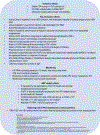Recommendations for analytical antiretroviral treatment interruptions in HIV research trials-report of a consensus meeting
- PMID: 30885693
- PMCID: PMC6688772
- DOI: 10.1016/S2352-3018(19)30052-9
Recommendations for analytical antiretroviral treatment interruptions in HIV research trials-report of a consensus meeting
Abstract
Analytical antiretroviral treatment interruption (ATI) is an important feature of HIV research, seeking to achieve sustained viral suppression in the absence of antiretroviral therapy (ART) when the goal is to measure effects of novel therapeutic interventions on time to viral load rebound or altered viral setpoint. Trials with ATIs also intend to determine host, virological, and immunological markers that are predictive of sustained viral control off ART. Although ATI is increasingly incorporated into proof-of-concept trials, no consensus has been reached on strategies to maximise its utility and minimise its risks. In addition, differences in ATI trial designs hinder the ability to compare efficacy and safety of interventions across trials. Therefore, we held a meeting of stakeholders from many interest groups, including scientists, clinicians, ethicists, social scientists, regulators, people living with HIV, and advocacy groups, to discuss the main challenges concerning ATI studies and to formulate recommendations with an emphasis on strategies for risk mitigation and monitoring, ART resumption criteria, and ethical considerations. In this Review, we present the major points of discussion and consensus views achieved with the goal of informing the conduct of ATIs to maximise the knowledge gained and minimise the risk to participants in clinical HIV research.
Copyright © 2019 Elsevier Ltd. All rights reserved.
Conflict of interest statement
Figures
References
-
- Sneller MC, Justement JS, Gittens KR, Petrone ME, Clarridge KE, Proschan MA, et al. A randomized controlled safety/efficacy trial of therapeutic vaccination in HIV-infected individuals who initiated antiretroviral therapy early in infection. Science translational medicine 2017;9(419). - PMC - PubMed


